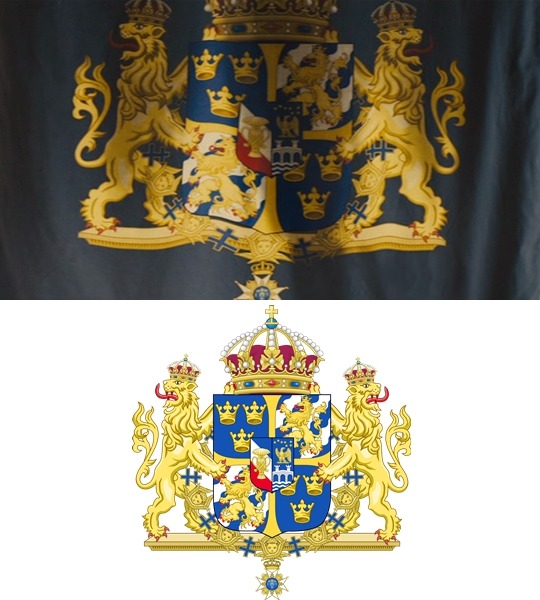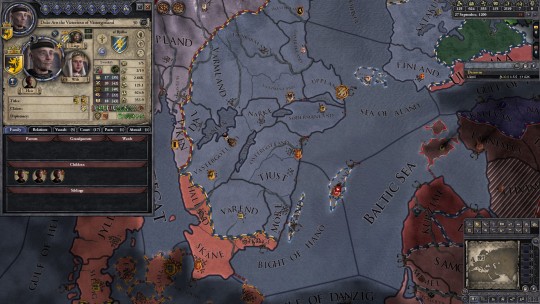#House of Bjälbo
Explore tagged Tumblr posts
Text

Blanche of Namur (1320-1363), Queen of Norway and Sweden as the wife of King Magnus VII / IV.
#blanche de namur#kingdom of sweden#kingdom of norway#Kongeriket Norge#Kongeriket Noreg#Konungariket Sverige#House of Bjälbo#House of Folkung#Bjälboätten#Folkungaätten#house of dampierre#maison de dampierre
4 notes
·
View notes
Photo

Blazon: Gules a lion rampant crowned, bearing an axe or bladed argent
Happy Norwegian Constitution Day! Today commemorates the signing of the Norwegian Constitution in 1814. While Norway did have to enter the Union of Sweden and Norway after their defeat in the Campaign Against Norway, the constitution helped ensure that it remained at least partly its own state. With - you know why we’re here - its own coat of arms!
Norway’s coat of arms is up there with the German eagle in terms of “longest use.” There are contemporary sources that show Norwegian kings using a lion rampant (for a somewhat loose definition of “lion”) in the mid-thirteenth century - certainly in 1247 - 1248, possibly as far back as 1225. The golden crowned lion on a red field was used by the House of Sverre, who ruled Norway until 1319, when the house of Folkung (also called Bjälbo) took over. The final Sverre monarch, Haakon V, had no male children, but his daughter Ingeborg had a son, who inherited the throne when Haakon died. That son, Magnus IV and VII, was the first king to hold Sweden and Norway in personal union; however, despite several personal-union combinations of various Scandinavian nations through the centuries, the Norwegian arms themselves don’t seem to have been affected. Various kings placed them in various quarters or on escutcheons of pretense, but the link between the country of Norway and the lion-and-axe was already well-established.
Speaking of the axe, it was most likely added to the arms around 1280, and was certainly there by 1295. It symbolizes Olaf II, who reigned from 1015 through 1028. His history has been somewhat corrupted by his legend (but the legend is probably more fun anyway.) He unified a significant amount of the peninsula, converted to Roman Catholicism in Normandy, including a baptism in Notre Dame, and (probably didn’t really) lead an attack on Anglo-Saxon England that destroyed London Bridge. However, he was driven into exile in 1029 when Cnut the Great invaded. Olaf made a brief, abortive attempt at a reconquest, but died in battle in 1030. He was canonized shortly after his death, becoming St. Olaf, and patron saint of Norway. He is often depicted with an axe, which, according to legend, is the weapon that killed him. The depiction of the axe varies; the long-handled poleaxe or halberd was most common during the early sixteenth century through 1844. Oscar I authorized a redesign of the arms in that year which returned to the shorter-handled battleaxe of the medieval period.
Mercifully, Norway escaped both the Napoleonic and Soviet varieties of unfortunate heraldic design, so I get to wrap things up here without inflicting those upon your eyes. Congratulations on 206 years of having a constitution, Norway!
9 notes
·
View notes
Text
Great Coat of Arms of Sweden
First I want to say “I fucking knew it!” The coat of arms shown at the end of Eggsy and Tilde’s wedding is the actual Great Coat of Arms of the Kingdom of Sweden. Then I suppose I have to admit that checking this was one of the main reasons I went to watch it in cinema for a second time...
And now when I’ve finally got my DVD + time to do this, let me bore you with some information about it and tell you how this proves (against all my personal headcanons) that Tilde is a Bernadotte and part of the longest reign royal family in Swedish history (celebrating 200 years this year).

The first picture is the best screengrab I managed as the camera swept past it in the church and the second is the Great Coat of Arms of the Kingdom of Sweden. As you can see, they are the same!
A coat of arms is, in simple terms, a symbol of a person, family, or organization. Sweden has two official coats of arms, a greater one (as seen above) and a lesser one. (you can see it here) The greater one is the personal coat of arms of the Head of State. In other words, it’s the monarch’s coat of arms. The lesser one is, in lack of a better way of phrasing it, ours. Never mind that it’s used for the government, the police, the military etc. It belongs to all Swedes, not as in “we all have a coat of arms” but as in “we’ve claimed the symbol of the three golden crowns and you can try stopping us from using it.” Like... our national hockey teams which just landed in South Korea are officially called “The Three Crowns” and “The Lady Crowns” and wears them on their uniforms.
Moving on, you’re not interested in that... and I wasn’t supposed to talk about the lesser one. The lesser one is, however, part of the greater one, so I’m allowed.
How much Swedish history can you stomach? None? Okay. Sorry, I can’t do that.
I can, however, start with the actual Kingsman fandom relevant part.
As I said, the greater coat of arms is the monarch’s personal coat of arms. It represents the reign king or queen -- in this case, Tilde’s dad -- and by extension their family.
The crown, the lions, the four quarterings, the collar of the Royal Order of the Seraphim, and the golden cross are all pretty generic symbols in Swedish royal heraldry tradition. The inescutcheon (which I like to call the heart shield, but have been told it’s not called at all) on the other hand is used to show hereditary arms. Which means, going by how they use the actual Great Coats of Arms of the Kingdom of Sweden, that Tilde’s dad is a Bernadotte.
What this means in terms of inverse reality, I don’t know. It goes against all my headcanons and makes me low-key sad since I’m going with a counterfactual history where Prince Karl Adolf didn’t die and actually became king making the inverse royal family of Holstein-Gottorp. I might get back to exploring how to shoehorn Tilde into the Bernadotte later. ETA: I thought about it! Here it is! Short story: our currently king was never born, Prince Bertil is Tilde’s grandfather.
Now, let’s get back to the coat of arms if anyone is still interested!
To the left of the inescutcheon is the coat of arms for House of Vasa. The first Swedish king of this house, Gustav Eriksson Vasa, is the reason thousands of idiots travel 90 km on skis between Sälen and Mora each year and the rebel who made his country leave a union 500 years before David Cameron was born.
(Side note to all the Danes out there: if you honestly believe Sweden was Danish during the Kalmar Union then you can’t claim that Denmark exists anymore since Denmark is a part of the European Union.)
Gustav Eriksson Vasa was a rebel, a reformer, a businessman, a tyrant, an oath breaker, a child wedder, a murderer, and... the one who lay the foundation of the Lutheran protestant tax loving Sweden we see today. He was also the person who decided that the Swedish crown should be passed on from father to son. And that’s his family coat of arms.
The right side of the inescutcheon is the coat of arms of Jean Baptiste Bernadotte as prince of Ponte Corvo and Marshal of France (which -- and this I had to look up -- apparently is a combo of Napoleon Bonaparte’s and Ponte Corvo’s coats of arms). Those of you who knows your Swedish history, knows that Jean Baptiste Bernadotte had a tattoo on his chest that said “Death to kings” which is ironic since he died as King Charles XIV John of Sweden. (If you really know your Swedish history you know that the part about the tattoo is untrue, but it’s a good story.)
The first and fourth quartering (I want to say third, because math, but sure) are the coat of arms for Albrekt of Mecklenburg who was King of Sweden in the late 14th century. He created it after overthrowing the House of Folkung and deciding that it wouldn’t do to use their coat of arms as his own.
Why he decided on three crowns or what they might symbolize has been debated over the centuries, but it’s likely that it’s either the three wise men or the three kingdoms Sweden once was. Or why not both? Either way, it’s ours now.
Also, tough luck, Albrekt! Guess what! The second and third quartering are the coat of arms of the House of Folkung -- the golden lion on three silver rods on blue background. (If anyone has watched the Swedish movie Arn - The Knight Templer then it might interest you to know that he’s a Folkung.)
The collar around the shield is the collar of the Order of the Seraphim which Tilde’s mum and dad wears at the dinner with Eggsy. The crown is there because it’s royal and the lions... there are always lions. I’m sure there’s a fascinating story somewhere but I can’t be arsed to look it up.
Lastly, the golden cross. It is, unsurprisingly, the cross from the flag. There is this lovely myth about Saint Erik, king of Sweden back in the day when we were Catholics in the 12th century, being away at a crusade in Finland (because it’s what you did back then) and seeing a burning cross in the sky and hearing God’s voice telling him that under this symbol, he would be victorious. In a more atheistic version of the story, it’s an old rebel flag when Charles VIII of Sweden (that’s Karl Knutsson Bonde for all the Swedes out there) went to war against the Danes in the 15th century, using Albrekt and the House of Folkung’s colours as inspiration for a remake of the Danish red and white flag.
Even if all of the things in the former paragraph can and should be taken with a grain of salt, known is that Charles VIII was the one who designed the coat of arms shield that is used today and that the Swedish flag is considered the second oldest national flag in the world, the Danish being the oldest.
(Last, I just want to say that I’m sorry, I know it’s often preferred to call House of Folkung the House of Bjälbo these days to avoid confusions, but I honestly wouldn’t know who I was talking about if I did. #oldschoolhistory)
9 notes
·
View notes
Text
Arn Magnusson af Bjälbo, the Folkunga House of Sweden in Crusader Kings 2.

Made Arn Magnusson, the fictional Swedish templar by Jan Guillou, with the in-game CK2 and CK2+ character creator in honor of getting The Kingdom at the End of the Road book.
Might, if I find time and interest, make a mod version.
0 notes